
The Solar-Terrestrial Centre of Excellence (STCE) is a collaborative network of the Belgian Institute for Space Aeronomy, the Royal Observatory of Belgium and the Royal Meteorological Institute of Belgium.
 |
Published by the STCE - this issue : 20 Sep 2012. The Solar-Terrestrial Centre of Excellence (STCE) is a collaborative network of the Belgian Institute for Space Aeronomy, the Royal Observatory of Belgium and the Royal Meteorological Institute of Belgium. |
| Archive of the newsletters | Subscribe to this newsletter by mail |
Filaments are clouds of cooler gas trapped between magnetic fields of opposite polarity. Seen in suitable filters, they look like dark lines and strands against the hotter solar disk. Near the limb, when their silhouette is observed, they glow as towering, torches, hedges and arches. They are then called prominences.
During the evening hours of September 9th, a small but dynamic filament turned around the southwestern solar limb, very near the southern solar pole. Only a few hours later (morning of September 10th), the magnetic regions surrounding the prominence became unstable, and an ejection of the material took place. This can be seen in images from the Sun's chromosphere made by the GONG-observatories (http://halpha.nso.edu/ ).
A few hours later, the coronal mass ejection (CME) was also observed with the coronagraphs onboard STEREO-A (http://stereo.gsfc.nasa.gov/ ), showing a pear-shaped cloud of ionized gas (plasma) moving away from the Sun. Such CME's have a mass comparable to that of a well-sized Alp mountain, and a speed in excess of 1.5 million kilometers per hour. A good thing this CME was not directed towards Earth!

Interestingly, some of the erupting material was captured by the Sun's magnetic field and graciously guided back into the lower solar atmosphere. This can be seen as a brightening south of an active (bright) region near the southwestern limb. The brightening is only seen in the EUV-clips, not in H-alpha, meaning that the crashing of the ejected material into the denser lower atmosphere of the Sun took place in the lower corona (above the chromosphere). The speed of the plasma at the end of the 750.000 km long loop is on the average half a million kilometers per hour!
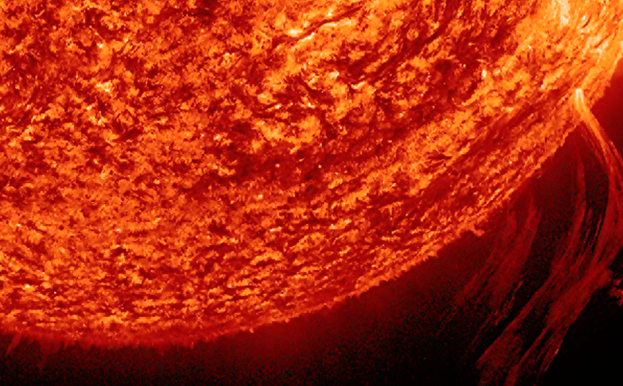
A clip of the event can be seen at http://www.youtube.com/watch?v=aafHnjAhxEM It shows:
- the filament and subsequent prominence eruption in H-alpha (GONG);
- the CME as seen by STEREO-A's coronagraph. Note the CME is on the southeast part of the Sun (lower left), because of the satellite’s position;
- the part of the material that is flowing back to the Sun. It consists of a combination of EUV-images by SDO (http://sdo.gsfc.nasa.gov/ ) and by the wider field PROBA2/SWAP instrument (http://proba2.oma.be/ );
- zoom-in on the area with SDO-images (first AIA 171, then AIA 304). The beginning of both clips still show some part of the filament (dark, swinging strands,) very well before the final eruption.
- the EUV-view by STEREO-A where the ejected material can be seen returning to the Sun, albeit weakly (lower left, "east").
It is official: the 5th Solar Orbiter Workshop was a success!
177 (!) people from 17 countries discussed the scientific and technological challenges of the ESA-NASA Solar Orbiter satellite that will be launched in 2017.
It was a challenge indeed. How will all the instruments onboard operate in harmony and in what form will the data be transmitted to the Earth? We learned that also data on the board computer can get stuck in a traffic jam: if you need 10 lanes and only 5 are available, creative solutions need to be thought of.

Let's scroll through some tweets
Enjoying Manolis Georgoulis talk at #solorb5 -- how we might predict solar eruptions and the challenges that face us
....he's looking at estimating mass in moving prominences. Interesting stuff!
Looking forward to more #solorb5 tomorrow: lots of great talks ahead on eruptive processes in solar atmosphere and their impact on heliosphere
No speeches at the #solorb5 conference dinner! + lots of very good beers and very good food. I wish conference dinners were always like this
Can't see the wood for the trees in your data? Check out Skytek/TCD FOREST poster http://shar.es/usNYL
Solar Energetic Particles - it seems the more we understand, the more we have to learn #solorb5
#solorb5 - Erosion in space does exist: magnetic clouds are sensible things.
Loving Benoit's talk on erosion of magnetic clouds - my fave topic!!!
#solorb5 Feeling a bit dizzy after Zhang's talk about magnetic helicity
I'm free (ie no one from LOC asked me) to say that the #solorb5 meeting is great. Nice poster session with lots of beer-powered discussions
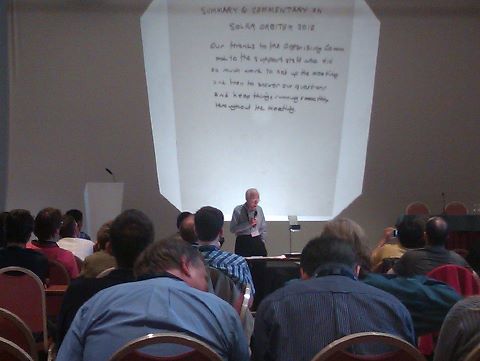
Parker's conclusion of the #solorb5 meeting was impressive. I felt like tweeting each of his remarks!
1 overhead projector, 3 acetates, and 8 decades of insight. Gene Parker brings #solorb5 to a fitting close.
Genuinely excited like a little kid to hear Gene Parker's take on #solorb5 meeting. I've never heard him speak at all!
1 overhead projector, 3 acetates, and 8 decades of insight. Gene Parker brings #solorb5 to a fitting close.
1 overhead projector, 3 acetates, and 8 decades of insight. Gene Parker brings #solorb5 to a fitting close.
Genuinely excited like a little kid to hear Gene Parker's take on #solorb5 meeting. I've never heard him speak at all!
Veronique Delouille has the unenviable task of being warm-up act for Gene Parker at #solorb5
Eugene Parker, father of solar wind and interplanetary magnetic field?, speaks at #solorb5 today. Should b fascinating.
Solar activity was very low during the past week with only moderate C-class flares. The most significant solar event was probably a filament eruption that took place close to NOAA Active Region 1566 on September 13 (around 06:00 UT), together with a Coronal Mass Ejection (CME).
Geomagnetic activity was very low during the week. The only noticeable event took place on September 12, when the Earth entered a mild fast solar wind stream (speed of about 450 km/s). No significant increase of the geomagnetic activity was detected.
Solar Activity
This week, the Sun's activity level was *Low*, evolving to *Very Low* during the last 3 days of the week.
In order to view the activity of this week in more detail, we suggest to go to the following website from which all the daily (normal and difference) movies can be accessed: http://proba2.oma.be/ssa. This page also lists the recorded flaring events.
On September 10th, an eruption from AR 11567 is prominent in the daily difference movie (see image below).
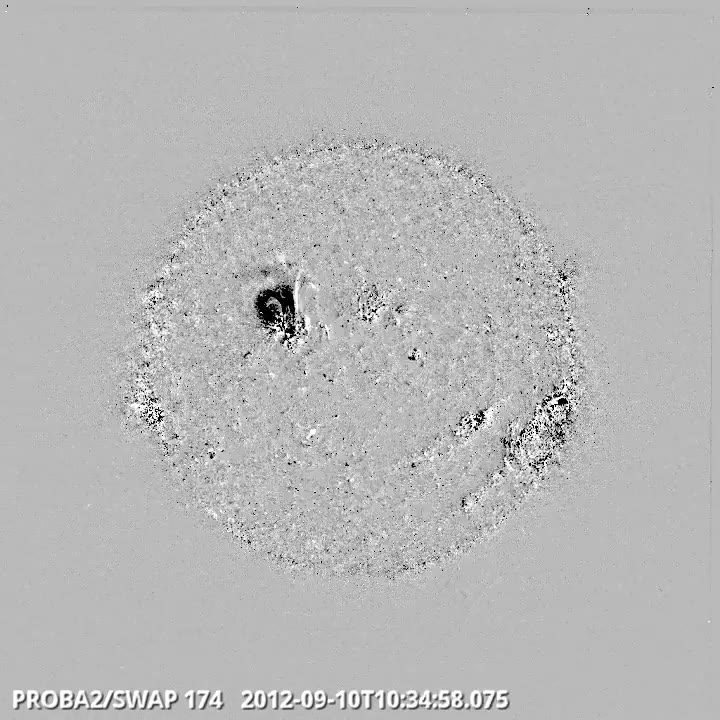
At approximately the same time as the above eruption, one can slightly distinguish the start of a prominence eruption close to the Southern Pole - in Western direction, some of its ejected material will be moving along magnetic field lines towards AR 11563. Below is a picture showing the end phase of the eruption, where material is dumped along the magnetic field lines. This eruption starts to be visible around 10:08 UT.
SWAP movies showing the above events can be found @ http://proba2.oma.be/swap/data/mpg/movies/20120910_swap_diff.mp4 (difference movie) and @ http://proba2.oma.be/swap/data/mpg/movies/20120910_swap_movie.mp4 (normal movie).

At other energy levels, this prominence eruption is more spectacular (see Helioviewer.org SDO/AIA/304 at the aforementioned time).
On Thursday 13th, two events can be observed in the early morning (UT).
In the North West quadrant, a filament located between AR 11566 and 11567 erupts around 06:13 (see pictures below and movie here: http://proba2.oma.be/swap/data/mpg/movies/campaign_movies/2012_09_13_BothErupt_NW_SE_SWAP_diff.mp4).
The first picture below is the SWAP difference image while the eruption is on-going. In the second one, the same can be seen in H-alpha (picture extracted from a GONG movie @ http://halpha.nso.edu/keep/ham/201209/20120913/20120913000000Lh_ALL.html ). In SDO/AIA/304 (see Helioviewer.org), this erupting filament can be seen to move over more than half the Sun’s surface before dissipating.

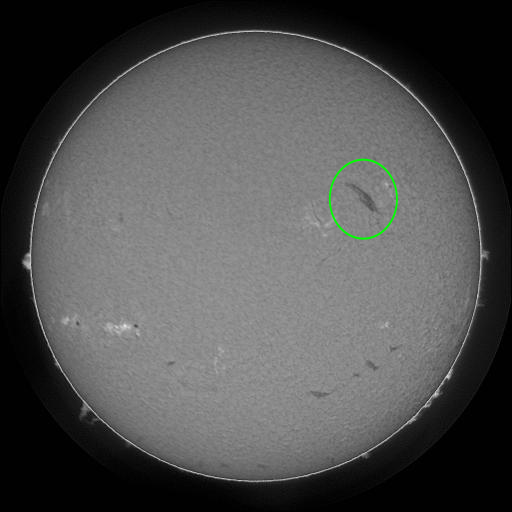
While the above eruption is ongoing (see the North West quadrant below), around 07:13, in the South East quadrant, an eruption (C1.8 flare) in AR 11569 blows material away towards a non active location with opposite polarity close to the center of the disk, right above the equator (see pictures below and movies @ http://proba2.oma.be/swap/data/mpg/movies/campaign_movies/2012_09_13_BothErupt_NW_SE_SWAP_diff.mp4).
Such material exchange between AR 11569 and its connection in the North happened several times during the day.
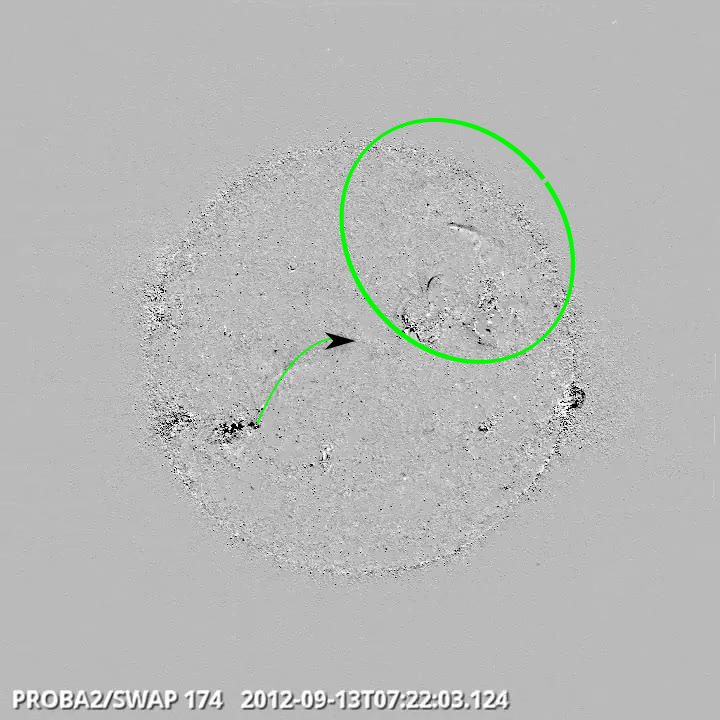
On Saturday 15th, a prominence eruption occurred on the North West limb, starting at 22:53 (see SWAP difference picture below):
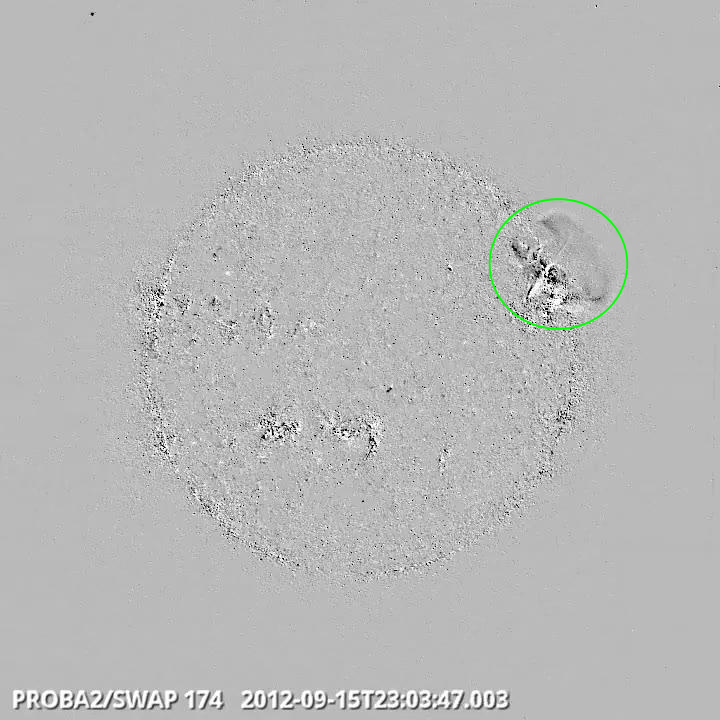
On Sunday 16th, around 4:00 UT, material is being transferred along field lines from AR 11573 to a non active region north of it (see SWAP difference picture below):

PROBA2 Science Days May 2012
http://www.spaceweather.eu/en/repository/show?id=242
http://www.spaceweather.eu/en/repository/show?id=243
PROBA2 Science Days May 2012
http://www.spaceweather.eu/en/repository/show?id=244
PROBA2 Science Days May 2012
http://www.spaceweather.eu/en/repository/show?id=245
PROBA2 Science Days May 2012
http://www.spaceweather.eu/en/repository/show?id=246
PROBA2 Science Days May 2012
http://www.spaceweather.eu/en/repository/show?id=247
PROBA2 Science Days May 2012
http://www.spaceweather.eu/en/repository/show?id=248
PROBA2 Science Days May 2012
http://www.spaceweather.eu/en/repository/show?id=249
PROBA2 Science Days May 2012
http://www.spaceweather.eu/en/repository/show?id=250
PROBA2 Science Days May 2012
http://www.spaceweather.eu/en/repository/show?id=251
The SALE Executive is pleased to announce that a set of high level talks on
various aspects of the energetic particle radiation hazard to aviation crews
and personnel aboard spacecraft in LEO will be presented at a meeting of the
Spacecraft, Aircraft and Launcher Environments group during Space Weather
Week in Brussels, Belgium (8 November, 2012).
Abstracts of these talks are attached and EVERYONE is cordially invited to
attend on this very special occasion.
http://www.spaceweather.eu/en/repository/show?id=252
Invited talk in the session Solar Magnetism and the Solar Cycle.
http://www.spaceweather.eu/en/repository/show?id=253
Start : 2012-09-24 - End : 2012-09-28
The 21st European Conference on RADIATION AND ITS EFFECTS ON
COMPONENTS AND SYSTEMS will be held in Biarritz, France, on
September 24-28, 2012.
The aim of RADECS conferences is to provide an annual European
forum for the presentation and discussion of the latest advances in
the field of radiation effects on electronic and photonic
materials, devices, circuits, sensors, and systems. The scope of
the conference encompasses technological processes and design
techniques for producing radiation tolerant systems for space,
aeronautical or terrestrial applications, as well as relevant
methodologies for their characterization and qualification. The
conference features a technical program, an Industrial Exhibit, and
one day meeting on ground effects offered on September 24
(RADGROUND). The technical program includes oral and
postersessions.
The areas of interest for contributions to be submitted to
RADECS 2012 include, but are not limited to:
* Basic mechanisms of radiation effects in electronic and
optical materials
* Space, atmospheric and terrestrial environments
* Radiation effects on electronic and photonic devices, circuits
and systems
* Radiation effects on sensors and emerging devices
* Technology and design hardening
* Radiation hardness assurance
* Irradiation facilities and testing
Website: http://radecs2012.org
Start : 2012-10-01 - End : 2012-10-05
At the forthcoming 63rd International Astronautical Congress in
Naples a special session on the theme 'Effects of Space Weather
on GEO
Satellites' will be held as part of
the 25th Symposium on Space Policy, Regulations and Economics.
This session will discuss case histories and mechanisms of
effects of space weather
on GEO
satellites, models for prediction,
and mitigation approaches. We would like to invite you to consider
submitting abstracts for this session.
The call for papers can be found at
The
deadline for abstract submission is 29 February 2012.
http://www.iafastro.org/docs/2012/iac/IAC2012_CallForPapers.
Website: http://www.iac2012.org/
Start : 2012-10-08 - End : 2012-10-12
Initiated in 1990, the United Nations Basic Space Science
Initiative (UNBSSI) has contributed to the international and
regional development of astronomy and space science through annual
workshops organized under the umbrella of the United Nations,
focusing specifically on the International Heliophysical Year 2007
(IHY, 2005-2009) and the International Space Weather
Initiative (ISWI, 2010-2012).
UNBSSI has led to the establishment of planetariums, astronomical
telescope facilities, and IHY/ISWI instrument arrays worldwide,
particularly in developing nations. ISWI is envisioned to continue
the tradition of IHY in the worldwide deployment of space weather
monitoring instrument arrays. To
date, ISWI contributes to the observation of space weather
through 18 instrument arrays with
close to 1000 operating instruments in more than 100 nations
supported by designated national ISWI coordinators.
The first workshop on ISWI was held in Helwan, Egypt and hosted
by the Helwan University, Egypt, in 2010, particularly for the
benefit of nations in Western Asia. In 2011 the United
Nations/Nigeria Workshop on ISWI was hosted by the Centre for Basic
Space Science of the University of Nigeria at Nsukka, Nigeria,
particularly for the benefit of nations in Africa. The third ISWI
workshop will be hosted by Ecuador in 2012 for the region of Latin
America and the Caribbean.
Website:
http://iswiecuador.epn.edu.ec/
Start : 2012-10-22 - End : 2012-10-24
2012 - 2013 is expected to be years with high solar activity.
This can trigger larger solar storms which can generate geomagnetic
induced currents (GIC
) on the earth. GIC
can affect the normal operation of
specific industrial operations and critical infrastructure (e.g
power grids, telecom, navigation systems, etc).
During space weather
events, like solar storms, electric
currents in the magnetosphere
and ionosphere
experience large variations, which
manifest also in the earth's magnetic field. These variations
induce currents (GIC
) in conductors operated on the
surface of the earth. Electric transmission grids and buried
pipelines are common examples of such conductor systems. GIC
can cause problems, such as
increased corrosion of pipeline steel and may disturb and possible
damaged high-voltage power transformers and it can also have
damaging effects on communication systems, navigation systems and
oil and gas operations.
Vulnerable industries are the oil and gas industry, railways,
telecommunication industry, navigation industry and not at least
the society, which is very vulnerable concerning short or long term
interruption of critical infrastructure.
The conference will focus on increasing the general knowledge of
solar storms, space weather
and GIC
and the possible consequences for
different industries and critical infrastructure, and look into
reasonable means of protection, and consider possible early warning
solutions.
Website:
http://www.tiems.info/about-tiems/oslo-conference-2012.html
Start : 2012-11-05 - End : 2012-11-09
We are pleased to announce that the Ninth European Space Weather
Week will take place at the
Académie Royale de Belgique, Brussels, Belgium between 5
and 9 November 2012.
This meeting is being jointly organised by the Solar-Terrestrial
Centre of Excellence (STCE), ESA
, the SWWT and the COST ES0803
communities. The local organisation is done by the STCE. This event
will continue to build on the advances made during the first eight
European Space Weather
Weeks held between 2004 and
2011.
Website:
http://www.sidc.be/esww9/
Start : 2012-11-06 - End : 2012-11-09
The International Symposium on Solar-Terrestrial Physics will be
held during November 6 - 9, 2012 at the Indian Institute of
Science, Education and Research, Pune, India. This meeting under
the aegis of the SCOSTEP is expected to draw leading scientists
from around the world in the increasingly important,
interdisciplinary fields of Solar activity and its impact on
geospace and life on the Earth. With major observational solar
facilities being planned in India, this meeting is especially
pertinent in the Indian context.
The meeting is expected to involve professional scientists as
well as graduate students, and will have a mixture of invited and
contributed talks and posters. There will also be a one-day
tutorial for the benefit of young people beginning work in the
field of solar-terrestrial physics.
Website:
http://www.iiserpune.ac.in/~isstp2012/
Start : 2012-11-12 - End : 2012-11-16
As we emerge from one of the deepest and longest solar minima on
record, with a new and powerful eye on the Sun -SDO- we invite all
those with an interest is solar activity to gather in beautiful
Palm Cove, Australia to review and assess our current knowledge and
understanding of our magnetic star
, and to experience the awe and
wonder of a total solar eclipse on November 14, 2012.
Website:
http://moca.monash.edu/eclipse/
Start : 2012-11-13 - End : 2012-11-13
For more information:
http://eclipse.gsfc.nasa.gov/OH/OH2012.html#SE2012Nov13T
Start : 2012-11-15 - End : 2012-11-16
The European Commission will organise the 'Let's embrace
space - FP7 Space Conference 2012', in cooperation with the Cypriot
EU Presidency, on 15 and 16 November 2012 in Larnaca, Cyprus.
This scientific conference will present the current status and
results of the 3rd call of FP7 space research, and also discuss
future options for European research in the space field. In doing
so, the conference will aim at demonstrating the evolution and use
of space tools for a sustainable economic and environmental
development in a European and global context.
Website:
http://www.fp7-space.eu/news-119.phtm
Start : 2012-11-20 - End : 2012-11-23
Nobeyama Radioheliograph (NoRH) has been observing the Sun since
1992. This year is the 20th year of science operation. Instruments
are still in good shape and producing images of the Sun every day
with the same quality as the beginning. Due to the nature of the
instrument and long and uniform observations, data can be used for
wide variety of solar physics and also for solar terrestrial
physics. To mark the 20 years of operation, we will organize a
symposium to summarize what has been done with NoRH and to discuss
what we should do in the future. Papers to be presented in the
meeting will be mainly concerned with the results from NoRH and
future plans.
Website:
http://st4a.stelab.nagoya-u.ac.jp/SPRO2012/
Start : 2012-11-30 - End : 2012-12-05
The overarching objective of the conference is to examine the
connections amongst the phenomena that lead to solar eruptive
events. The current state of themes includes:
* Measuring the Coronal Magnetic Field;
* Connections to, and Reactions of, the Large-Scale Corona;
* Large-scale Magnetic Connectivity of Active Regions;
* Transfer of Energy to, and Storage of Energy in, the
Corona;
* The High-Energy Particle - Flare - CME
connection.
Working groups will address topics such as:
* Energy Transfer throughout a Solar Eruptive Event;
* Global Energetics of an Ensemble of Events;
* Coronal Influences to the Lower Atmosphere;
* CME
Initiation and Type II Bursts;
* The Release of Energetic Particles in the Low Corona;
* Flows vs. Waves;
* Microflares/Nanoflares.
Website:
http://hessi.ssl.berkeley.edu/petaluma/index.shtml
Start : 2013-01-13 - End : 2013-01-19
Information coming soon!
Website:
http://sd-www.jhuapl.edu/Aurora/ESSE/index.html
Start : 2013-03-03 - End : 2013-03-08
Living With a Star
's Solar Dynamics Observatory
invites you to its 2013 Science Workshop to be held March 3-8, 2013
at the Hyatt Regency Chesapeake Bay in Cambridge, MD
(http://chesapeakebay.hyatt.com/). The workshop is a follow-on to
the 'Many Spectra of Solar Activity' workshop held May 1-5, 2011 in
Squaw Valley, CA.
Scientific sessions will feature a broad spectrum of science
topics fundamental to SDO's science investigations:
Atmospheric Imaging Assembly (AIA), EUV Variability Experiment
(EVE), and Helioseismic and Magnetic Imager (HMI), as well as the
overlap between SDO and other scientific missions and
activities.
Website:
http://lws-sdo-workshops.org/
Start : 2013-03-10 - End : 2013-03-15
Spacecraft observations have established that all magnetized
planets in our solar system interact strongly with the solar wind
and possess well-developed
magnetotails. Magnetotails are the site for many dynamic processes
critical to the circulation of mass, energy and magnetic flux. The
great differences in solar wind
conditions, planetary rotation
rates, ionospheric conductivity, and physical dimensions from
Mercury's small magnetosphere
to the giant magnetospheres of
Jupiter and Saturn provide an outstanding opportunity to extend our
understanding of the influence of these factors. Therefore, this
Chapman conference will provide a forum in which various
communities can come together and discuss recent achievements of
observational, theoretical, and modeling studies with the objective
to develop a deeper understanding of fundamental properties and
processes of planetary magnetotails through a comparative
examination.
Start : 2013-05-10 - End : 2013-05-10
For more information:
http://eclipse.gsfc.nasa.gov/SEplot/SEplot2001/SE2013May10A.GIF
Start : 2013-06-10 - End : 2013-06-16
Topics:
* Prominences : formation, dynamics
* Prominence plasma properties, including prominence
seismology
* Magnetic field : measurements, topology, support
* Large-scale patterns and cyclic evolution
* Prominence destabilization, CMEs, reconstruction in 3D
* ICMEs in the heliosphere, magnetic clouds; their impact on the
Earth environment
* Stellar quiescent and eruptive prominences and stellar CME
* Requirements for future instrumentation and prospects for
future missions
Website:
http://www.iau.org/science/meetings/future/symposia/1065/
Start : 2013-06-24 - End : 2013-06-29
Solar cycle 24 has opened a new era in solar radio physics as we
now have instruments that can probe solar processes from
sub-millimeter to kilometer waves. ALMA and LOFAR are entering
full-operation state and observations of the Sun will be made in
the near future.
At the same time extensive use is being made of radio
spectrometers in space, STEREO
/WAVES and Wind
-WAVES, and existing and upgraded
ground-based instruments like Nobeyama Radioheliograph, Nancay
Radioheliograph, Ratan, SSRT, and many others. These instruments
provide data that enable studies of both energetic particles and
thermal plasma
, enhancing our knowledge of solar
eruptions and acceleration and propagation of particles, all
through the solar chromosphere
and corona and into interplanetary
space.
The CESRA 2013 Workshop will highlight these new observational
capabilities and discuss the theoretical issues connected to solar
radio emission and interplanetary radio physics.
Website:
http://wave.asu.cas.cz/cesra2013/
Start : 2013-07-08 - End : 2013-07-11
The 2013 meeting of the AAS/SPD will be July 8-11 (and possibly
July 12), hosted by the Solar Physics Group of Montana State
University, in Bozeman, Montana.
Website:
http://solar.physics.montana.edu/SPD/
Start : 2013-11-03 - End : 2013-11-03
For more information:
http://eclipse.gsfc.nasa.gov/SEplot/SEplot2001/SE2013Nov03H.GIF